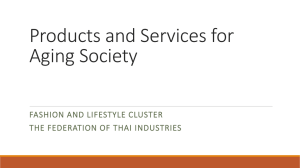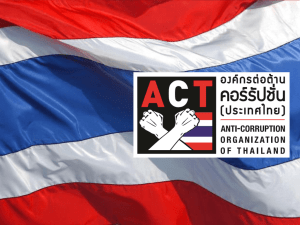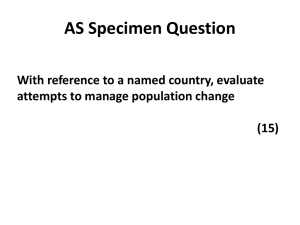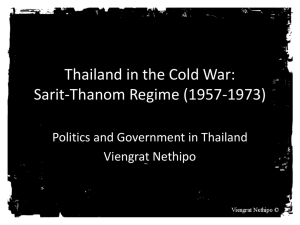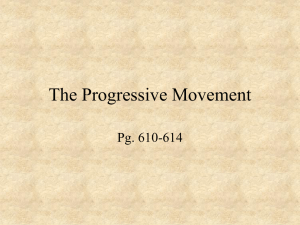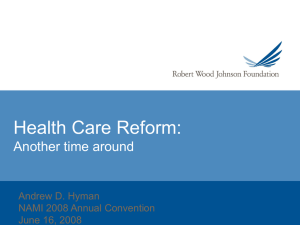Thailand * Forward Looking
advertisement
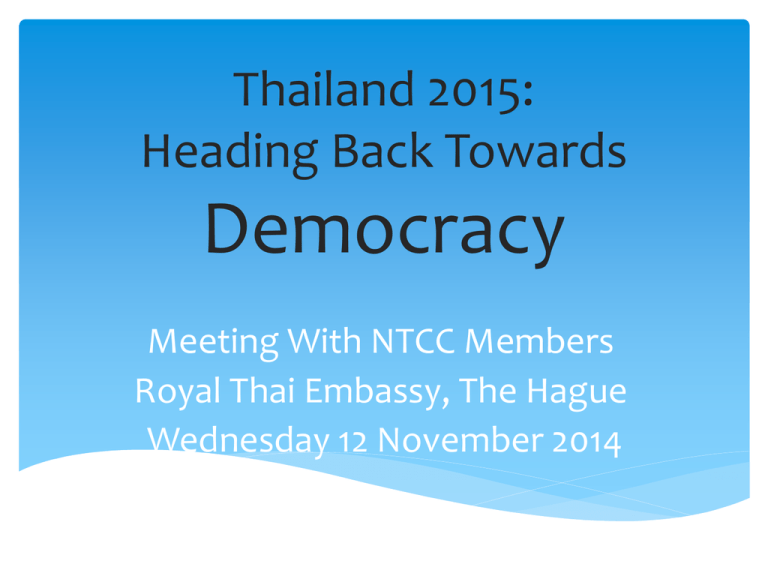
Thailand 2015: Heading Back Towards Democracy Meeting With NTCC Members Royal Thai Embassy, The Hague Wednesday 12 November 2014 A Democracy Now Temporarily “under Maintenance” 1932 – Thailand adopted western style democratic constitutional monarchy. 2014 – Political impasse with a dysfunctional democracy. Time to pause and pose the right questions about Thai “democracy” and find the best way forward. 2 Where we are now Transition period to implement a 3-phase Roadmap back to democracy: end of confrontations, reform and elections. Now in 2nd phase: move the country forward under provisional constitution while conducting reforms, strengthening our democratic institutions, and getting the economy going. 3rd phase: general elections under a truly democratic system accepted by all sides expected by the end of 2015 3 Provisional Constitution of the Kingdom of Thailand B.E. 2557 Promulgated on 22 July 2014, containing 48 sections Five principal political institutions : 1. National Legislative Assembly (NLA) 2. Council of Ministers 3. National Reform Council (NRC) 4. Constitutional Drafting Committee (CDC) 5. National Council for Peace and Order (NCPO) 4 The National Legislative Assembly (NLA) Performs functions of National Parliament, including passing legislations, approving Emergency Decrees, and approving treaties. 220 members appointed by the NCPO 5 The National Reform Council (NRC) 250 members selected from a pool of 935 nominations from all social and professional sectors and 77 representatives from each provinces based on their professional merit and track record. To undertake a comprehensive reform of the country in 11 areas and draw up recommendations for the Constitution Drafting Committee. 6 11 Reform Agenda Groups Politics Public Administration Law and judicial procedures Local administration Education Economy Energy Public health and environment Mass communication Social Affairs Others 7 Six Goals Of National Reform A democratic system which conforms with Thai society and culture Transparent and fair elections An effective anti-corruption mechanism Social and economic equality Effective law enforcement Availability of public services to all on an equal footing 8 The Constitutional Drafting Committee (CDC) - On 4 November 2014, 36 members of CDC have been nominated by the National Reform Council, the National Legislative Assembly, the Cabinet and the NCPO, at the ratio of 20:5:5:6 respectively - Consists of legal experts, academics, former senators, judges, civil servants, representatives from NGOs and the media 9 Key Issues For Constitution Drafting Ensure a truly democratic constitutional monarchy. Set up an efficient mechanism to tackle corruption. Set up a legal framework to ensure accountable spending of State budget. Set up a legal framework to prevent populist public administration leading to long-term economic damages. Incorporate inputs from the National Reform Council and public opinions. 10 The National Council for Peace and Order (NCPO) To maintain peace and security in the country. To ensure a smooth reform process. 11 The Council of Ministers General Prayut Chan-o-cha, appointed Prime Minister by Royal Command in August 2014 upon nomination by the National Legislative Assembly. A 32-member Cabinet. 12 Political Priorities of the Government Strengthen the national administration system and enhance and expedite decentralisation. Expeditiously resolve immediate problems facing the nations. Modernize laws and regulations. Move forward the reform and reconciliation process. Tackle human trafficking and improve management of foreign migrant workers. Fight against corruption through legal reform. 13 Economic Priorities of the Government Maintain financial and monetary discipline. Maintain public debt level at less than 60 % of GDP. Undertake tax and energy reform (e.g. new Power Development Plan (PDP)). Restructure State enterprises. Invest in public infrastructure (e.g. 10-year Infrastructure Development Plan (2016-2025)). Ensure development of value-added agricultural products. Enhance “digital economy” (a Digital Economy Act to be proposed to the NLA by 2014). Formulate a comprehensive master plan for water management. 14 Concrete economic measures With a view to helping economy to recover towards a growth rate of 4-5 per cent in 2015, a three-month economic stimulus package (October-December 2014) (worth USD 11.2 billion) has been announced, of which USD 10 billion will be allocated to job creation and USD 1.2 billion for direct payments to farmers (in order to stimulate the grassroots economy). Since the appointment of the new Board of Investment (BOI) in June 2014, 603 projects of foreign direct investment (worth USD 14.07 billion) have been approved with investment incentives. 15 Regional Cooperation Priorities Manage border areas and set up special border economic zones. Enhance Thailand’s participation and role in ASEAN community for common peace and prosperity. Improve infrastructure for transport and logistics connectivity to facilitate regional economic integration, with Thailand as hub. 16 Special Economic Zones (SEZs) Seven SEZs will be established along the borders. Five areas have been designated for early implementation in 2015. The aims of SEZs are to promote local economies, strengthen the country’s regional supply chains and provide opportunities for foreign investors to benefit from Thailand’s market access in ASEAN. Foreign investors who decide to invest in SEZs will be helped to expand their investments to Thailand’s neighbours under the “Thai Plus One” investment policy. 17 Latest Opinion Poll “Dusit Poll” conducted on 26 October 2014 shows: 86.6 % satisfied with the NCPO performance during the first 5 months in office as it did well to control situation and create stability and discipline in society as well as its decisiveness and effectiveness to solve problems 13.4 % unsatisfied because of the NCPO’s dictatorial tendency and obstruction of free expression 18 Where We Are In Some Figures GDP forecast for 2014: US$ 380 billion. GDP growth forecast for 2014: 1.4-1.5 % (3.5-4 % for 2015). Public Debt (5/2014): US$ 19.7 billion; ratio to GDP: 46.6 % (Q2/2014) Inflation forecast for 2014: 1.9-2.4 % Unemployment rate (6/2014): 1.2% Trade Balance Forecast for 2014: US$ +21.8 billion. Current Account Balance Forecast for 2014: US$ +9.9 billion. Official Foreign Reserves (8/2014): US$ 168.21 billion. Car production Jan-Aug 2014: 1.2 million units (2.5 million units in 2013). 19 Ties With the Netherlands As Strong As Ever Thai export to the Netherlands (Jan-Aug 2014): US$ 3.02 billion. Thai import from the Netherlands (Jan-Aug 2014): US$ 703.21 million. Dutch investment in Thailand through Thai Board of Investment approval (2013): US$ +1 billion. Number of Dutch tourists visiting Thailand (2013 and 2014 forecast): +200,000. Thais living (happily) in the Netherlands (2014): around 16,000. 20 We are optimistic Remains second-largest economy in Southeast Asia (Oxford Business Group, The Report : Thailand 2014). Ranks 31st (world) and 8th (East Asia) in World Economic Forum’s Global Competitiveness Report 2014 – 2015. Ranks 8th in World Investment Report 2014. Ranks 18th (world) and 5th (East Asia) in World Bank’s Doing Business 2014. Confidence has returned and growth restored. 21 We are realistic Immediate challenges that must be addressed: Good governance: Thailand ranks only 102nd in 2013 for corruption perception index (CPI). Quality of the education system. 22 How We See Things This “maintenance” period is only temporary. We remain committed to democracy and human rights. We are trying to heal the Country “the Thai way”. We are on the road to a functioning and sustainable democracy. In the mean time, it’s business (and fun) as usual. We need understanding and support from our friends. 23 THANK YOU 24

